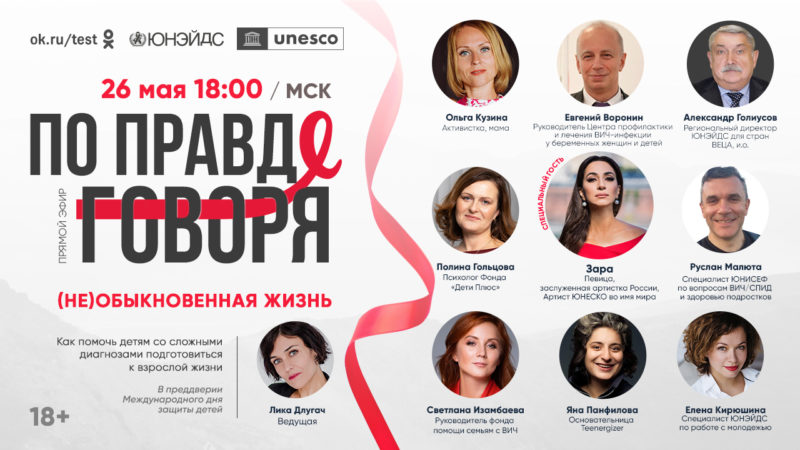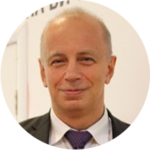What particular challenges do children and teens living with HIV face, how one can answer their questions about living with this tough diagnosis, and what can be done to support a child with HIV on his or her path to adulthood – all of this and more was discussed during a livestream of the series “Po Pravde Govorya” (Telling the Truth), an educational talk show by UNAIDS, UNESCO and Odnoklassniki social media network. The talk show was broadcast on the eve of June 1st, the International Day for Protection of Children. The heroes of the show were parents and young people who shared personal stories of accepting themselves and their diagnosis, overcoming difficulties and achieving self-fulfillment. Together with healthcare professionals, psychologists, activists, and UNAIDS and UNICEF experts, they came up with a few basic principles for effective support of children, teens and young adults in the face of unpredictable reactions from other people to their diagnosis, related stigma and discrimination, and their own fear and loneliness. The two-hour talk show received more than 1.3 million views and numerous questions and comments from Odnoklassniki users.
According to UNAIDS, the number of adolescents and young people aged 15 to 24 living with HIV in Eastern Europe and Central Asia has increased by 12% and reached 70,000 over the past five years. While unprotected sex is the main route of HIV transmission, sporadic cases of mother-to-child transmission still occur in EECA countries.
Mr Alexander Goliusov, Director of the UNAIDS Regional Support Team for Eastern Europe and Central Asia (EECA), provided more statistics of mother-to-child HIV transmission in the EECA region and explained how the current low rates have been achieved:
Russia has demonstrated good progress in preventing mother-to-child HIV transmission: now, approximately 98% of all children born to HIV-positive mothers do not have the virus. The main reason for this success is that almost all pregnant women with HIV receive the ARV therapy. While the average for the EECA region is 96%, a few countries such as Armenia, Belarus, the Republic of Moldova and Armenia have received a certificate from the World Health Organization (WHO) that validates their elimination of mother-to-child transmission of HIV. The transmission rates in these countries are below 2%.
Mr Evgeny Voronin, Head of the Russian Center for HIV Prevention and Treatment in Pregnant Women and Children, explained what is necessary for preventing mother-to-child transmission:
Women who are aware of their HIV diagnosis and plan to get pregnant need to start the antiretroviral therapy as soon as possible in order to have an undetectable viral load by the time they conceive and continue taking the ARVs throughout pregnancy; then the risk of HIV transmission to the baby at birth is virtually zero.
Those children who are born with HIV, provided they are diagnosed and started on the ARV therapy in time, can live a long and happy life; their life expectancy does not differ from that of other children.
Ms Olga Kuzina, mother of two and activist of the E.V.A. Nonprofit Partnership that helps women and teen girls living with HIV, shared her own experience and expressed support for all parents and legal guardians of children affected by the epidemic:
[Raising a child with HIV] is a challenging journey. But there are people around you who can help you out! I urge everyone not to become isolated in their grief as they struggle with their problems and fears alone. Please, ask for help when you need it. There are organizations, support groups, counsellors, specialists, friends and family who can support you. Then your problem will no longer seem hopeless.
Ms Polina Goltsova, psychologist and head of the Kids Plus Foundation‘s counselling service, advised parents to start talking with their child about the HIV diagnosis early on:
Even a very young child who is curious about their health and how their body works can be engaged in a conversation about what they can do to take good care of themselves and their health. This information should be given out gradually, in an age-appropriate way, making sure that the child can understand and integrate it, and then more information can be added at the next age stage. According to the World Health Organization, a child should have received full information about their disease by the time they are 7 to 12 years old. But when exactly they will learn about it is up to their parents or legal guardians. And it is up to us to convince the parents that they can give out this information to the child safely, with appropriate preparation.
The psychologist notes in particular that children with HIV should understand that they cannot put their peers at risk just by having HIV.
Therefore, the child’s school or other educational institution does not need to know that the child has HIV. No situation can arise in school setting where a child with HIV may put others at risk. Teenagers should also understand that regularly taking their ARVs makes their viral load undetectable. Therefore, they do not pose any danger to anyone.
Mr Ruslan Malyuta, HIV/AIDS and Adolescent Health Officer at the UNICEF Regional Office for Europe and Central Asia, continues the discussion of challenges faced by children with HIV at school:
Almost one in three teens is bullied at school. Children with chronic diseases and conditions are particularly vulnerable to bullying. We must act in the best interests of every child! And we also need to protect children from stigma and discrimination.
Stigma is about other people’s attitudes, but discrimination is the result of official policies. When a girl wishing to work as a beautician or a young man aspiring to become a chef are required to take an HIV test, these are examples of discrimination. Because we all know that HIV cannot be not transmitted through cooking and food or through beauty care. These are examples of institutionalized discrimination. They are the reason why children with HIV are so worried about their future! The less discrimination they face, the more comfortable life will be for teens and children with HIV. Educating teachers and health professionals is what helps prevent stigma and discrimination at school.
Ms Svetlana Izambaeva, mother of three and founder of the Svetlana Izambaeva Foundation, shared some of the problems causing HIV-positive children and teens to seek help:
Some parents hide the HIV diagnosis from their children until as late as age 17. This makes some youngsters to wonder what they have – maybe cancer? It is essential to educate parents so that they can deal with their own feelings of guilt and know how to talk to their children. Many children with HIV live in single-parent families, some are raised by legal guardians or grandparents, and some are orphans. Therefore, steps must be taken to help each child cope with his or her loss and grief.
Teenagers living with HIV can feel socially isolated and lonely, because they are afraid to tell others about their diagnosis. What if they reject me? These youngsters may have low self-esteem and serious concerns about their future. Will I be able to give birth to a healthy baby? What occupation can I choose? Children living with HIV often ask these questions.
And perhaps the most important thing is that even for an adult, accepting the HIV diagnosis is often hard. Can you imagine what it can be like for a child at age 10 or 12? To cope with it effectively, a child absolutely needs a supportive adult near them – a mentor, preferably a family member, such as a parent or a grandparent, whom the child can trust.
The Svetlana Izambayeva Foundation is the organizer of a retreat for children and teens living with HIV. The name of the retreat – It’s SIMPLE! – reflects, according to Svetlana, the core principles of providing assistance to youth living with HIV:
“S” for Strength. Helping youth embrace their inner strength to trust the world.
I” for Information. Providing them with information about their diagnosis, ARV therapy, and their rights.
“M” for Medicine. Being able to access quality medical care is essential.
“P” for Protection and support from peers, support groups and community.
And finally, “L” for love.
In the final part of the broadcast, Ms Yana Panfilova, founder of the Teenergizer Eurasian Union of Adolescents and Youth, spoke about treatment adherence challenges often experienced by teens living with HIV:
Unfortunately, teens with HIV often stop taking their ARVs for various reasons. Together with UNAIDS, we surveyed them about these reasons. It turns out that some youngsters struggle with discussing the treatment with their parents. This is especially true for those who were not born with HIV but acquired it later. It can be extremely difficult for them to talk to parents about their diagnosis and the need to take ARVs.
Some others do not fully understand the importance of taking ARVs. When you take a pill for your headache and it stops, you can feel the effect. But when you take ARVs, nothing seems to happen. When you stop taking them, you may feel great for a while! However, then, after a few months or years, you may be having health problems.
Ms Elena Kiryushina, UNAIDS Regional Youth Officer for Eastern Europe and Central Asia, explained why treatment adherence can be particularly challenging for teens:
Adolescence as such is often a risk factor. Teens experience major changes in and around them: from their bodies to their relationship with parents. They begin to separate from family to feel more independent. Their relations with peers change, and they enter into their first romantic relationships. Add to this society’s negative attitudes and low HIV awareness, which is common among younger people. The situation sometimes becomes even worse due to mental health issues, such as depression. Therefore, adolescents living with HIV really need our help. How can we help them? Various types of support are essential, including sometimes professional assistance from a psychologist or psychiatrist. Teens with HIV must be followed by a medical doctor. And they also need supportive people around, such as a parent, a foster parent or a close friend.
The celebrity guest of the show, UNESCO Artist for Peace, singer Zara emphasized what should be at the heart of all assistance and support for children, teens and young people living with HIV:
Creativity and love are at the heart of everything. Regardless of race, skin color, belief or diagnosis, we all need to be human above all! And, of course, HIV education must be provided at school from an early age. Indeed, schools should not just teach children but also prepare them for living their life. Being a mother of two, I know quite well that children can be mean and cruel out of ignorance. Talking to children is so important, because it helps us avoid difficult situations, prevent stigma and discrimination.
The recorded broadcast can be accessed at the UNAIDS and UNESCO’s page “It Affects Even Those Who Are Not Affected” in Odnoklassniki.







